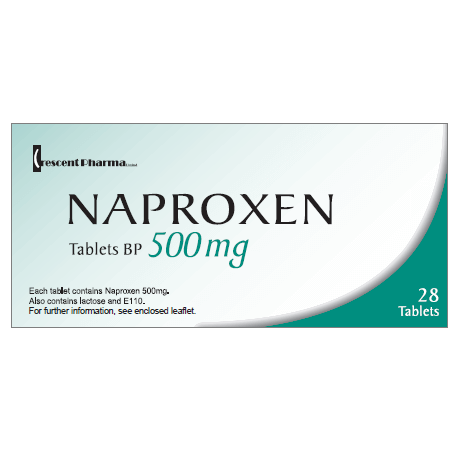*Brands may vary. please contact us for specific brands.
Naproxen Tablets (28 Tablets)
£14.99 – £21.49
- Used To Relieve Pain In Joints And Muscles
- Non-Steroidal Anti-Inflammatory
- Active Ingredient: Naproxen
- Buy With Confidence From UK Registered Pharmacy
- Includes Free Prescription
Pain relief for conditions such as rheumatoid arthritis, osteoarthritis, bursitis, tendinitis, period pain, back pain, shoulder pain, knee pain, and more.
| Options | Price | Stock |
|---|---|---|
| 250mg | £14.99 | In Stock |
| 500mg | £21.49 | In Stock |

Discreet Packaging

UK Based
-
Naproxen Tablets
- Order Naproxen Online UK from My Pharmacy
- Naproxen - The Best Pain Relief Available Online
- Understanding the Use of Naproxen
- How Naproxen Works
- How To Take Naproxen
- Possible Side Effects of Naproxen
- Deciding Between Naproxen 500mg or Naproxen 250mg
- Interaction with Other Medicines and Substances
- Conclusion
Order Naproxen Online UK from My Pharmacy
Our dedication to offering quick, efficient, and secure service sets us apart. Purchase Naproxen 500mg online and benefit from our next-day delivery service. We prioritise your privacy, ensuring your medicines arrive in discreet, undamaged packaging, every time.Naproxen - The Best Pain Relief Available Online
Are you searching for an effective pain relief solution online? Look no further than Naproxen. Naproxen is an NSAID (non-steroidal anti-inflammatory drug), which is useful for managing a variety of conditions, such as rheumatoid arthritis, osteoarthritis, period pain, back pain, bursitis and tendinitis. Whether you're struggling with muscular discomfort, joint problems or menstrual pain, Naproxen can provide much-needed relief. Buy Naproxen tablets online on our website today after a free online consultation and rediscover your mobility and comfort.Understanding the Use of Naproxen
Naproxen is a versatile medicine which works to ease symptoms such as pain, swelling, redness and heat associated with muscle, joint, and tendon problems like strains, gout, ankylosing spondylitis, dental pain or arthritis. It's also a preferred option for managing period pain. By limiting the body's production of substances that trigger inflammation (prostaglandins), Naproxen not only provides relief but also addresses the root cause of the discomfort. It has established its position as one of the top pain relief medicines online. Order Naproxen from My Pharmacy by filling out our free consultation form today.How Naproxen Works
So, how does Naproxen alleviate pain? By inhibiting the enzymes cyclooxygenase-1 (COX-1) and cyclooxygenase-2 (COX-2), it reduces the production of prostaglandins, which are responsible for pain and fever. However, it's important to note that while COX-2 triggers inflammation, COX-1 protects your stomach lining, explaining why NSAIDs may sometimes cause ulcers. For a comprehensive understanding of Naproxen, you can visit the Naproxen BNF page. This will clarify any remaining questions about Naproxen's application.How to Take Naproxen
The correct dosage and frequency of Naproxen for you to take will be based on your condition. Typically, Naproxen should be taken with a full glass of water, with or after a meal to help protect your stomach. You should also avoid lying down for at least 10 minutes after taking the medication. If you forget to take a dose, take it as soon as you remember unless it's almost time for your next dose. Don't double up on the next dose to make up for a missed one. If you're unsure about what to do, consult with your healthcare provider or pharmacist.Possible Side Effects of Naproxen
Like any medication, Naproxen might cause side effects, though not everyone who takes it will experience them. If you encounter any worsening symptoms after using Naproxen, it's advisable to consult your doctor immediately. Possible allergic reactions can include:- Facial swelling
- Skin reactions
- Difficulty breathing
- Confusion
- Headaches
- Drowsiness
- Dizziness
- Rashes
- Changes in vision
- Irregular heartbeat
- Depression
- Difficulty sleeping
- Light Sensitivity
Deciding Between Naproxen 500mg or Naproxen 250mg
The choice between Naproxen 500mg and Naproxen 250mg depends on the condition being treated. Your doctor will typically prescribe the lowest effective dose to minimise the risk of side effects. Naproxen 500mg is usually prescribed for conditions with significant inflammation and pain such as rheumatoid arthritis, osteoarthritis, and ankylosing spondylitis. The higher dosage provides more effective pain relief and inflammation control for these conditions. On the other hand, Naproxen 250mg is often sufficient for managing less severe conditions or symptoms, such as muscle aches, dental pain, or menstrual cramps. This lower dosage can effectively manage your symptoms while minimising potential side effects.Interaction with Other Medicines and Substances
Interactions between Naproxen and other substances such as alcohol, paracetamol, ibuprofen, and co-codamol should be considered before taking this medication. Drinking alcohol while taking Naproxen can increase the risk of stomach bleeding. Combining Naproxen with paracetamol is generally safe, as they can be taken at different intervals. However, Naproxen and ibuprofen, both being NSAIDs, should not be taken together due to their similar working mechanism and side effects. Co-codamol, an opioid-type painkiller, can be taken concurrently with Naproxen to enhance pain relief, especially in conditions such as arthritis. Always consult your healthcare provider before combining Naproxen with other medications or substances.Conclusion
At My Pharmacy, we are committed to providing you with safe and efficient pain relief solutions. Naproxen has proven to be an effective choice for numerous patients dealing with different types of pain. While there are alternatives like Mefenamic Acid for period pain and Ibuprofen tablets, Naproxen holds its ground as a trusted and reliable choice for many. Browse through our extensive range of pain relief treatments here and select the one that suits your needs best. Watch this YouTube video from My Pharmacy to learn more about Rheumatoid Arthritis. https://www.youtube.com/watch?v=PoOixRt4Iac -
Pain Relief
Types of arthritis
Arthritis is a common condition that causes pain and inflammation in a joint. In the UK, around 10 million people have arthritis. It affects people of all ages, including children.
The two most common types of arthritis are:
Osteoarthritis
Rheumatoid arthritisOsteoarthritis
Osteoarthritis is the most common type of arthritis in the UK, affecting around 8 million people.
It most often develops in adults who are in their late 40s or older.Osteoarthritis initially affects the smooth cartilage lining of the joint. This makes movement more difficult than usual, leading to pain and stiffness.
The most commonly affected joints are those in the Hands,Spine,Knees andHips
Rheumatoid arthritis
In the UK, rheumatoid arthritis affects more than 400,000 people. It often starts when a person is between 40 and 50 years old. Women are three times more likely to be affected than men.
Rheumatoid and osteoarthritis are two different conditions. Rheumatoid arthritis occurs when the body’s immune system targets affected joints, which leads to pain and swelling.
The outer covering (synovium) of the joint is the first place affected. This can then spread across the joint, leading to further swelling and a change in the joint’s shape. This may cause the bone and cartilage to break down.
Other types of arthritis and related conditions
Ankylosing spondylitis – a long-term inflammatory condition that mainly affects the bones, muscles and ligaments of the spine, leading to stiffness and joints fusing together.Fibromyalgia – causes pain in the body’s muscles, ligaments and tendons.
Gout – a type of arthritis caused by too much uric acid in the body. This can be left in joints (usually affecting the big toe) but can develop in any joint. It causes intense pain, redness and swelling.
Psoriatic arthritis – an inflammatory joint condition that can affect people with psoriasis.Enteropathic arthritis – a form of chronic, inflammatory arthritis associated with inflammatory bowel disease (IBD), the two best-known types being ulcerative colitis and Crohn’s disease.
Secondary arthritis – a type of arthritis that can develop after a joint injury and sometimes occurs many years afterwards.
Polymyalgia rheumatica – a condition that almost always affects people over 50 years of age, where the immune system causes muscle pain and stiffness, usually across the shoulders and tops of the legs. It can also cause joint inflammation.
Period pain
Period pain is common and a normal part of your menstrual cycle. Most women experience it at some point in their lives.It’s usually felt as painful muscle cramps in the tummy, which can spread to the back and thighs.
The pain sometimes comes in intense spasms, while at other times it may be dull but more constant.
What causes period pain?
Period pain occurs when the muscular wall of the womb tightens (contracts).
During your period, the wall of the womb starts to contract more vigorously to encourage the womb lining to shed away as part of your monthly period.When the muscular wall of the womb contracts, it compresses the blood vessels lining your womb. This temporarily cuts off the blood supply – and hence oxygen supply – to your womb. Without oxygen, the tissues in your womb release chemicals that trigger pain.
While your body is releasing these pain-triggering chemicals, it’s also producing other chemicals called prostaglandins. These encourage the womb muscles to contract more, further increasing the level of pain.
Period pain caused by a condition
Less commonly, period pain can be caused by an underlying medical condition. Doctors sometimes call this secondary dysmenorrhoea.Period pain linked to an underlying condition tends to affect older women. Women aged 30 to 45 are most commonly affected.
Conditions that can cause period pain include:
endometriosis – where cells that normally line the womb start to grow in other places, such as in the fallopian tubes and ovaries; these cells can cause intense pain when they shed and fall away
fibroids – non-cancerous tumours that can grow in the womb and can make your periods heavy and painful
pelvic inflammatory disease – where your womb, fallopian tubes and ovaries become infected with bacteria, causing them to become severely inflamed
adenomyosis – where the tissue that normally lines the womb starts to grow within the muscular womb wall, making your periods particularly painful -
Further Information
Side Effect
More common side effects
The more common side effects that occur with naproxen oral tablet include:
Stomach pain
Constipation
Diarrhea
Gas
Heartburn
Nausea and vomiting
Dizziness
Mild side effects may go away within a few days or a couple of weeks. Talk to your doctor or pharmacist if they’re more severe or don’t go away.Serious side effects
Call your doctor right away if you have serious side effects. Call 911 if your symptoms feel life-threatening or if you think you’re having a medical emergency. Serious side effects and their symptoms can include the following:
Chest pain
Shortness of breath or trouble breathing
Weakness in one part or side of your body
Difficulty speaking
Swelling of the face or throat
High blood pressure
Bleeding and ulcers in your stomach and intestines, with symptoms such as:
Stomach pain
Bloody vomit
Blood in your stool
Black and sticky stool
Asthma attacks in people who have asthma
Low red blood cell count, which can cause fatigue, lethargy, and weakness
Yellowing of your skin or the whites of your eyes
Unusual weight gain or swelling of your arms, legs, hands, and feet
Skin rash or blisters with fever













